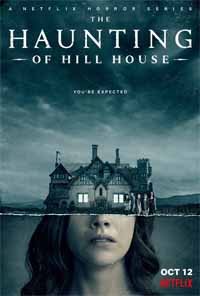
Oh boy, this is going to be a tough one to talk about. I have very mixed, and somewhat polarized views of how this turns out, and as such, I'm struggling with whether or not I can offer a recommendation. The first five or six episodes are fantastic! After that, however, I really feel like the show peters out, begins to meander and run in place, and then kind of unravels in the end. Those first five or six episodes are so good, however, that I think I can recommend the series as a whole based on the strengths of its first half.
I can't discuss this show without getting into spoilers, so be warned that the further down you read, the more spoiler-y this will become.
A masterfully suspenseful start
Each of the first five or six episodes is told from the point of view of a different sibling in a family that is tormented by a summer spent in a haunted house. This structure creates a deeply textured and nuanced tapestry, in which each episodes recasts the events of the previous episodes in a new light. Giving each character his or her own episode provides us with a rich character study that helps us to understand each character's attitude when they all get together and the family drama gets rolling. All the while, the subtle supernatural elements create a building sense of intrigue as the mysteries surrounding Hill House, and the family's last night there, continue to mount and the plot continues to thicken.
Each of the first six episodes is told from the perspective of a different character.
I really love the camera work! Slow pans and zooms are used with excellent effect to draw out scenes and add tension and keep the scene mysterious. Sometimes, there's a creepy detail in the background. Other times, there's an ominous lack of anything creepy to see as the camera slowly pans from character to character across a room or down a hallway. In any genre other than horror, these labored camera movements would seem wasteful and pointless, but they really add to the atmosphere here.
The set design is also really great. The gothic Hill House provides an excellent and ominous set piece, but the other sets are also uncanny and unnerving in their own right, especially Shirley's funeral home. Around episode 6 or 7, I was really starting to struggle with reconciling the geometry of Hill House, and this is something that is paid off really well at the end of the series.
The geometry of Hill House becomes a source of unease as the series develops.
A meandering, incoherent ending
Unfortunately, the series faltered a bit for me after the sixth episode. At this point, all the characters are together in one place, and so no one character receives the focus of the narrative. The story starts to meander a bit here, while also running in place, as the intrigue that was so carefully crafted in the preceding episodes is squandered, new plot points and concepts are thrown at the audience, and old plot points and concepts just disappear.
... [More]
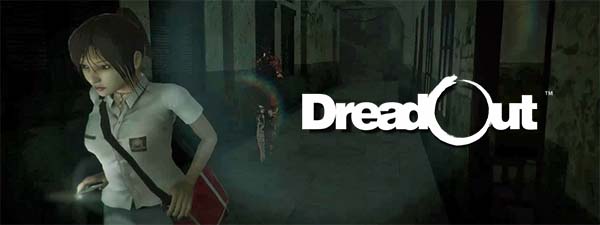
The opening moments of DreadOut set the bar pretty low for what was to come. The visual quality varies wildly. The main character, Linda, looks and animates decent enough, but the other characters all look incredibly stiff and robotic. And they sound almost as stiff and robotic. I'm not sure if it's a matter of poor translation, cultural disconnects, or if it's a deliberate attempt by the developers at camp, but the dialogue and voice acting is cringe-worthy. It wasn't even laughably bad. It was just bad. Don't worry though, you won't have to put up with them for long. They'll disappear for the majority of act 1, rendering the game's futile attempts at early character-building moot, and likely leading to you forgetting that they ever existed until they reappear later. The ghosts and monsters themselves actually get better development and depth, as each one is given a thematic backstory, and its aesthetic design attempts to represent that theme - with varying degrees of success.
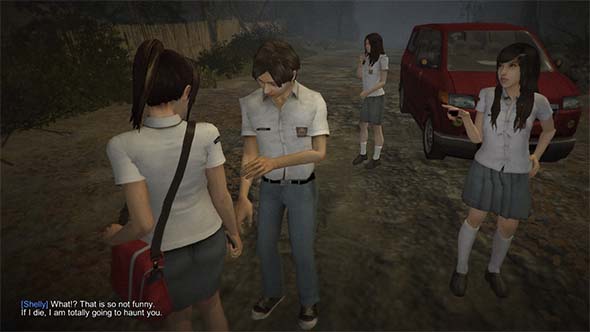
Dialogue and voice-acting might have been going for deliberate camp, but ends up just being bad.
It's an indie game, so I don't expect its graphics to impress on any technical level. But what's presented on screen is often only passable for a PS2-era game, and there's very little artistry or detail in the majority of environments. Some of the environments are decent, and there's the occasional well-placed lighting or particle effect that helps to set a mood. That mood rarely lasts though, because you'll turn a corner and find repetitive environments and flat textures. It is very easy to get lost in a few areas of this game because so much of the environment looks the same. The school building was particularly bad, as all the classrooms had the same desks, chairs, and backpacks sitting around. Only two rooms in the entire building had unique decorations (a teacher's office and what appeared to be a biology lab). The difficult-to-read signposts and lack of any sort of in-game map just exacerbates the sameness of the game's environmental design.
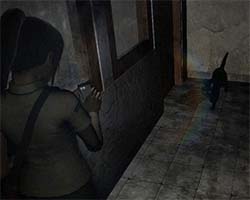
"Aw, hello Mr. Kitty!"
Oh, you're a black cat and are
supposed to be scary. My bad..
Gameplay is less a mixed-bag, and is more universally terrible. Movement is very clunky. The camera loves to pivot around when you go through doors, leading to temporary disorientation as you try to figure out which direction the character is facing. It doesn't help that so much of the game looks the same, so it's easy to get turned around and confused (or outright lost) when the camera wigs out on you.
There's a blue vignette effect that indicates a nearby item that is designed to work as a player aid, but sometimes it can be a hindrance. It works through walls, which I guess is fine since it can let you know that you need to go into a nearby room. What isn't fine is that it also seems to work through floors and ceilings. So the game will nag you that a useful item or clue is nearby, but it might be on a different floor of the building. So you end up wandering back and forth trying to find it - which you never will because it's not there... [More]
175d6d05-3fa8-4f7e-ad1b-458c00a80c3c|4|3.5
Tags:DreadOut, Digital Happiness, horror, indie gaming, Steam, Indonesia, ghost, school girl, camera, cell phone, photograph
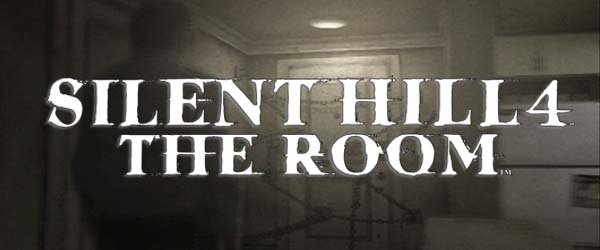
While I was playing through recent horror titles like The Evil Within, I noticed some interesting similarities with Silent Hill 4 that started to give me a new appreciation for some of this game's stronger aspects. In addition, while doing research for my Silent Hill timeline, I had to go back and play through Silent Hill 4: the Room again. I had only played through the game twice before, so I had to replay it in order to figure out how the timeline would work out. And while I was playing the game, I figured that I might as well go ahead and review it. At the time, it seemed like a novel idea to do a retro review of a Silent Hill game that wasn't Silent Hill 2, but lately, I've been seeing a lot of retro-reviews of The Room popping up other places. I haven't done any retro reviews yet; probably the closest thing has been my review of Demon's Souls. But in light of how unsuccessful the later Silent Hill games have been, the unfortunate cancellation of Silent Hills, and the uncertain future of the franchise (and of Konami as a studio), it's a good time to go back to look at what worked and what didn't about the previous games, and explore the question of whether we even want the franchise to continue.
The Room has the reputation of being the "bad" black sheep of the original Silent Hill tetralogy. I always thought that this reputation was unfortunate, and that the game wasn't quite as bad as people made it seem. I actually liked it better than Silent Hill 3 when I first played it, because I had never played the first Silent Hill. After I was able to track down a copy of the first game and play through it, Silent Hill 3 suddenly made a whole lot more sense, and I came to love it almost as much as I loved Silent Hill 2. So while I tend to agree that The Room is the "weakest" of the original Silent Hill games, I never really thought of it as being "bad"; just "less good". The release of future games by third party developers has only made The Room look better in retrospect.
An experimental formula
The game itself is a bit rough around the edges. It deviates significantly from the controls and mechanics established by the previous games in the franchise, and these changes are very hit-or-miss. This might be due, in part, to the possibility that The Room started out as an independent side project that was developed concurrently with Silent Hill 3, and that was eventually redesigned to work as a Silent Hill game in order to be more commercially viable. Whether or not that's true is still a hot issue of debate among the fanbase, but it's obvious to everybody that The Room plays a lot differently from previous titles.
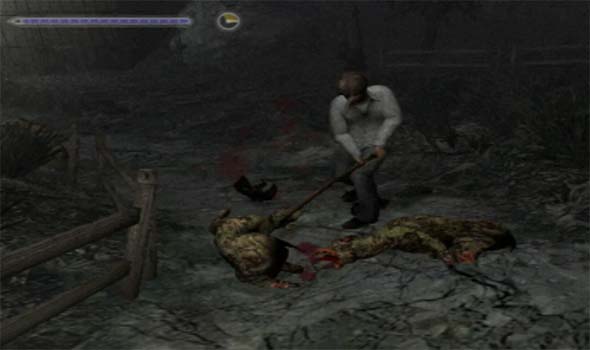
Movement and combat controls are radically changed from previous games in the series.
The most immediately obvious deviation is in movement and camera controls. The semi-first-person "tank" controls have been completely abandoned in favor of direct directional inputs, and the camera is significantly more limited than it has been in previous games. You can't snap the camera behind the character by holding the "look" button as you could do in previous games. Almost all camera angles are pre-set angles, and the player can usually only toggle between two possible camera angles in any given area.
This results in some very clumsy navigation of the environment, and it's very easy for the character to get turned around when camera angles flip. Most of the time, a camera change will go without a hitch, but there are a few frames in the game that consistently result in erratic and unpredictable movement. It happens most often when a camera change occurs concurrently with a change in direction of the character (to navigate around a corner or an obstacle). If the player's timing for changing the character's movement direction is not perfectly-timed, then the character ends up turning around, which can result in getting stuck in a loop between the two camera angles. This is the very reason that I prefer the tank controls. They may be a bit cumbersome, but at least they're consistent and always relative to a single frame of reference (the character's position in the world), rather than to an unpredictable camera.
The second major change is to combat. The game was designed to have a greater emphasis on melee combat, complete with new target-locking controls, a variety of breakable melee weapons, very limited ammunition for guns, and an on-screen meter for charging power attacks. The new movement controls do make it a bit easier to maneuver around enemies (especially multiple enemies), but only if you're in an open space and the camera angle doesn't go all wonky on you. The mechanics are serviceable, and I don't think they're as bad as some critics insist.
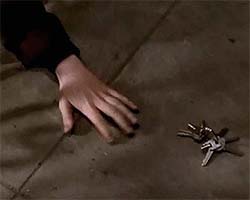
The designers were probably trying to mimic
the horror trope of fumbling for keys.
Inventory management is where things really start to get bad. Henry isn't a walking closet like the previous games' protagonists, and he has only a limited number of inventory slots. This is probably partly the result of the inventory being accessed in real-time by the directional buttons (which also might have played a role in the changes to the movement control scheme being entirely based up on the analog stick), in a desire to create a sense of frantically searching your pockets for a weapon or item while under pressure. It also adds more relevance to the Room 302 hub (another dramatic departure from previous games) by forcing you to go back to restock on supplies or swap out puzzle items.
But it's hindered by a lot of little mistakes... [More]
a5ccd49d-8af1-4839-8eb0-2796d3829980|6|4.5
Tags:Silent Hill, Silent Hill 4: the Room, Konami, Team Silent, KCET, Henry Townshend, Walter Sullivan, Eileen Galvin, room 302, horror, serial killer, murder, cult, occult, 21 Sacrements, sacrifice, ritual, ghost, escort quest, Alfred Hitchcock, retro review
|

| 12 | | | | | | | 60 | | 11 | | | | | | | 55 | | 10 | | | | | | | 50 | | 09 | | | | | | | 45 | | 08 | | | | | | | 40 | | 07 | | | | | | | 35 | | 06 | | | | | | | 30 | | 05 | | | | | | | 25 | | 04 | | | | | | | 20 | | 03 | | | | | | | 15 | | 02 | | | | | | | 10 | | 01 | | | | | | | 05 |
|